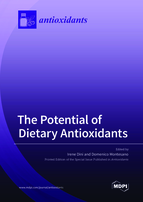The Potential of Dietary Antioxidants
A special issue of Antioxidants (ISSN 2076-3921). This special issue belongs to the section "Natural and Synthetic Antioxidants".
Deadline for manuscript submissions: closed (30 June 2021) | Viewed by 123309
Special Issue Editors
Interests: food chemistry; food analysis; antioxidant activity; nutraceutics; dietary supplements
Special Issues, Collections and Topics in MDPI journals
Interests: food safety and food quality; metabolomics; food chemistry; chromatography; mass-spectrometry; nutraceuticals; novel foods; methods of extraction
Special Issues, Collections and Topics in MDPI journals
Special Issue Information
Dear Colleagues,
The relationship between health and diet has been recognized since ancient times. A significant body of evidence shows that alteration of the cellular redox state is related to the production of reactive oxygen species, which play critical roles in various steps that initiate and regulate the progression of pathologies. Dietary antioxidants have high potential to act as nutraceuticals and drugs for the prevention or treatment of many chronic diseases, such as cardiovascular diseases, cancers, Alzheimer’s disease, and diabetes. Food fortification and dietary supplements are an alternative way of eating secondary plant metabolites with health properties.
Antioxidants are used as food additives to extend the shelf life of products by retarding adulteration of oxidizable foods (e.g., lipid oxidation) as well as in food packaging to prevent the discoloration of vegetables and fruits. They are also being applied in a new exciting cosmetic market: the nutricosmeceutical market. In this regard, functional foods, supplements, and beverages containing active molecules are used to increase human beauty, particularly in antiaging products. In recent years, numerous analytical methods have been developed to characterize and investigate the dosage of antioxidant compounds in food and supplements, and new nutrition delivery systems have been designed to permit their efficient distribution in the human body. However, unfortunately, excessive consumption of antioxidants is associated with negative toxicological effects.
This Special Issue of Antioxidants aims to collect research articles and review papers dealing with the potential uses of dietary antioxidants in food, cosmetic, and pharmaceutical applications. In particular, the following topics are of interest: the study of genetically modified foods with high antioxidant potential, the use of agricultural practices to increase the concentration of antioxidant compounds in food, analytical procedures to isolate compounds of interest, the evaluation of their health properties, toxicological aspects related to antioxidant abuse, and the development of targeted delivery systems.
The Italian Society of Food Chemistry (ItaChemFood) founded on 24/12/2018 as the organ of expression of the University Professors belonging to the Italian scientific disciplinary sector "Food Chemistry", is a free, non-profit, non-political, non-confessional, non-commercial association. Members are interested in the didactic, research and training aspects related to the chemical characterization and evaluation of FOODs raw and processed. Moreover, they are interested in the characterization of the bioactive compounds present in foods and food supplements, nutraceutical and functional foods and chemicals, aroma and flavourings aspects, undesirable substances such as contaminants and residues and their metabolites and catabolites through the development of appropriate innovative analytical methods and techniques.
Members focus their analytic skills on the compositional profiles of food, also to determine health claims and related authorization dossiers and the drafting of food labels relating to food safety.
Significant attention is spent on scientific dissemination. The Society recognizing the high value of food education and the importance of issues related to the relationship between food, health and food safety, promotes appropriate initiatives to increase the knowledge among the media and citizens, students of schools and the teaching system at various levels.

Prof. Irene Dini
Dr. Domenico Montesano
Guest Editors
Manuscript Submission Information
Manuscripts should be submitted online at www.mdpi.com by registering and logging in to this website. Once you are registered, click here to go to the submission form. Manuscripts can be submitted until the deadline. All submissions that pass pre-check are peer-reviewed. Accepted papers will be published continuously in the journal (as soon as accepted) and will be listed together on the special issue website. Research articles, review articles as well as short communications are invited. For planned papers, a title and short abstract (about 100 words) can be sent to the Editorial Office for announcement on this website.
Submitted manuscripts should not have been published previously, nor be under consideration for publication elsewhere (except conference proceedings papers). All manuscripts are thoroughly refereed through a single-blind peer-review process. A guide for authors and other relevant information for submission of manuscripts is available on the Instructions for Authors page. Antioxidants is an international peer-reviewed open access monthly journal published by MDPI.
Please visit the Instructions for Authors page before submitting a manuscript. The Article Processing Charge (APC) for publication in this open access journal is 2900 CHF (Swiss Francs). Submitted papers should be well formatted and use good English. Authors may use MDPI's English editing service prior to publication or during author revisions.
Keywords
- antioxidant activity
- phenolic compounds
- isolation and characterization
- metabolomics
- delivery system
- cosmetic supplement
- food supplement
- functional food
- nutraceuticals
- food additives
- genetically modified food
- toxicological properties
- biological activities
Related Special Issues
- Antioxidants in Foods in Antioxidants (22 articles)
- Dietary Antioxidants in Mediterranean Diet in Antioxidants (9 articles)








